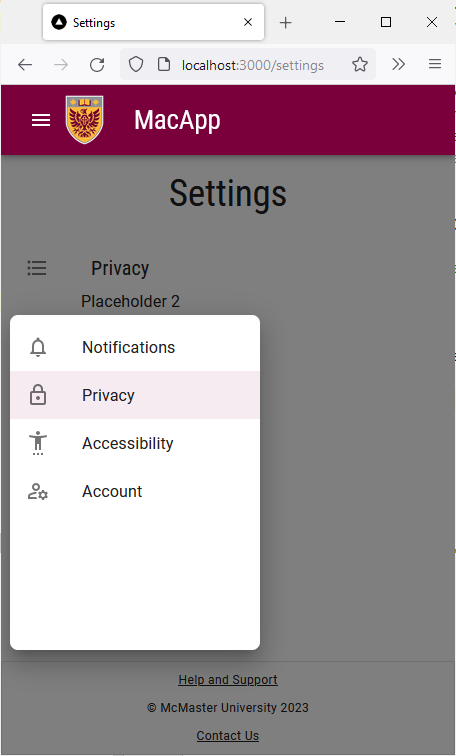Navigation Bar
When most people visit a website for the first time, the navigation bar (NavBar) is the first element that catches their attention. A responsive navigation bar links the different pages of a website together and provides the user with contextual information to identify which page they are currently on in addition to helping them understand the structure of the website. Consequently, having a responsive navigation bar is integral for creating a website that is intuitive and easy to navigate. In this section, we will learn how to create a responsive navigation bar using the AppBar component of Material UI.
Define the Palette Colors & Border Radius
Start by defining the primary and secondary colors of your theme. The McMaster Digital Brand Standards specify that the primary color should be McMaster Heritage Maroon and the secondary color is McMaster Heritage Gold.
Modify theme.ts by adding the following code at the beginning of the themeOptions object:
palette: {
primary: {
main: "#7a003c"
},
secondary: {
main: "#fdbf57"
}
},
In this code snippet, we are defining the primary and secondary colors of our website using the hex values that correspond to the McMaster Heritage Maroon and Heritage Gold colors.
Next, we will set the border radius in the them to 28 and the border radius for the MuiPaper component to 8 inside themeOptions:
shape: {
borderRadius: 28,
},
components: {
MuiPaper: {
styleOverrides: {
root: {
borderRadius: 8,
},
},
},
}
Note that the shape borderRadius sets the global value of the border radius for all MUI components, we will modify the border radius of individual components as needed just like we did for the MuiPaper component.
Your theme.ts file should now look like this:
import {Roboto, Roboto_Condensed} from "next/font/google";
const roboto = Roboto({
weight: ['400', '900'],
style: ['normal', 'italic'],
subsets: ['latin'],
display: 'swap',
})
const roboto_condensed = Roboto_Condensed({
weight: ['400', '700'],
style: ['normal', 'italic'],
subsets: ['latin'],
display: 'swap',
})
declare module '@mui/material/Typography' {
interface TypographyPropsVariantOverrides {
settingTitle: true;
}
}
const themeOptions = {
palette: {
primary: {
main: "#7a003c"
},
secondary: {
main: "#fdbf57"
}
},
typography: {
h1: {
fontFamily: roboto_condensed.style.fontFamily,
fontSize: '50pt',
fontWeight: 400,
},
h2: {
fontFamily: roboto_condensed.style.fontFamily,
fontSize: '28pt',
fontWeight: 400,
},
h3: {
fontFamily: roboto_condensed.style.fontFamily,
fontSize: '20pt',
fontWeight: 400,
},
h4: {
fontFamily: roboto.style.fontFamily,
fontSize: '13pt',
fontWeight: 900,
},
button: {
fontFamily: roboto_condensed.style.fontFamily,
fontWeight: 700,
},
settingTitle: {
fontFamily: roboto_condensed.style.fontFamily,
fontSize: '15pt',
},
},
shape: {
borderRadius: 28,
},
components: {
MuiPaper: {
styleOverrides: {
root: {
borderRadius: 8,
},
},
},
}
}
export default themeOptions
Create Navbar.module.css
In the styles directory of your project, create a new file called Navbar.module.css. This file will contain the CSS styles used for the links in our navigation bar. We will define the colors of the links in their active, non-active and hover states:
- Non-active links should be white and turn Heritage Gold when you hover over them.
- Active links should have a white background and the link text should be Heritage Maroon.
Add the following lines to Navbar.module.css:
/* Specific styles for non-active navbar links */
.nonActive {
color: white;
}
/* Specific styles for active navbar links */
.active {
color: #7a003c;
background: white;
}
.active:hover {
color: #7a003c;
background: white;
}
Download the McMaster Logo
Download the McMaster logo using the Brand Standardswebsite. Note that you will need to sign in with your MacID to download the logo. Rename the downloaded file to logo.png. In the public directory of your project, create a new directory called assets. Place logo.png in the assets directory.
We will also need the McMaster crest logo that can be downloaded from the following link. Rename the downloaded file to logo-small.png and place it in the assets directory.
Create Styled Icon Buttons
We will now proceed to create a styled IconButton for use in our navigation bar. In the root directory of your project, create a components directory. Create a new directory called MacComponents inside the components directory. Create a new file in this directory called MacNavButton.tsx and add the following code to it:
import {styled, useTheme} from '@mui/material/styles'
import IconButton from '@mui/material/IconButton'
export const MacIconNavButton = styled(IconButton)(props => ({
':hover': {
backgroundColor: "transparent",
color: useTheme().palette.secondary.main,
},
'&& .MuiTouchRipple-child': {
backgroundColor: "#D6D6D6",
},
})) as typeof IconButton
The MacIconNavButton component is a styled MUI IconButton. We set the icon color to Heritage Gold and made the background transparent when hovering over the icon button. We also added a ripple affect to the icon button that appears when the user clicks on it.
Create the NavBar Component
Create another directory inside the components directory called Navbar. Create a file named Navbar.tsx in this directory.
Add the following import statements to to Navbar.tsx:
import * as React from 'react'
import AppBar from '@mui/material/AppBar'
import Box from '@mui/material/Box'
import Toolbar from '@mui/material/Toolbar'
import Typography from '@mui/material/Typography'
import MenuIcon from '@mui/icons-material/Menu'
import Container from '@mui/material/Container'
import Link from 'next/link'
import {usePathname, useRouter} from 'next/navigation'
import styles from '@/styles/NavBar.module.css'
import {MacIconNavButton,} from '@/components/MacComponents/MacNavButton'
import {useTheme} from '@mui/material/styles'
import Tooltip from '@mui/material/Tooltip'
import Drawer from "@mui/material/Drawer";
import List from "@mui/material/List";
import ClearIcon from '@mui/icons-material/Clear';
Next, create a multi-dimensional array containing the name of each page and its corresponding .tsx file:
const pages = [
['Page 1', '/page_1'],
['Page 2', '/page_2'],
]
We will create the .tsx files shortly.
We will now create the Navbar function which returns the AppBar component:
export default function Navbar() {
const imgStyle = {
paddingTop: '10px',
paddingBottom: '10px',
paddingRight: '30px',
}
const [state, setState] = React.useState(false);
const toggleDrawer =
(open: boolean) =>
(event: React.KeyboardEvent | React.MouseEvent) => {
if (
event.type === 'keydown' &&
((event as React.KeyboardEvent).key === 'Tab' ||
(event as React.KeyboardEvent).key === 'Shift')
) {
return;
}
setState(open);
};
const pages_drawer = () => (
<Box
paddingTop={1}
sx={{ width: 250 }}
role="presentation"
onKeyDown={toggleDrawer(false)}
>
<List>
</List>
</Box>
);
return (
<AppBar
position="relative"
enableColorOnDark
style={{backgroundImage: 'none'}}
sx={{zIndex: theme => theme.zIndex.drawer + 1, borderRadius: 0}}
>
<Container maxWidth="xl">
<Toolbar disableGutters>
<Box sx={{flexGrow: 1, display: {xs: 'flex', md: 'none'}}}>
<MacIconNavButton
size="large"
aria-controls="menu-appbar"
aria-haspopup="true"
onClick={toggleDrawer(!state)}
color="inherit"
>
{state ? <ClearIcon /> : <MenuIcon />}
</MacIconNavButton>
<Drawer
anchor={"left"}
open={state}
onClose={toggleDrawer(false)}
sx={{
'& .MuiDrawer-root': {
position: 'absolute'
},
'& .MuiPaper-root': {
position: 'absolute',
borderRadius: 0
},
minWidth: 100,
width: "20%",
position: "absolute",
top: '70px',
display: {xs: 'flex', md: 'none'}
}}
>
{pages_drawer()}
</Drawer>
<Box
justifyContent="center"
alignItems="center"
sx={{alignItems: 'center', display: {xs: 'flex', md: 'none'}}}
>
<Box
component="img"
sx={{
height: 70,
width: '100%',
}}
alt="McMaster Logo"
src="/assets/logo-small.png"
style={imgStyle}
/>
<Typography
variant="h3"
component={Link}
href="/"
sx={{
mr: 2,
flexGrow: 1,
color: 'inherit',
textDecoration: 'none',
"&:hover": {
color: useTheme().palette.secondary.main
}
}}
>
MacApp
</Typography>
</Box>
</Box>
<Box
component="img"
sx={{
height: 78.31,
width: 140,
display: {xs: 'none', md: 'flex'}
}}
alt="McMaster Logo"
src="/assets/logo.png"
style={imgStyle}
/>
<Typography
variant="h3"
noWrap
component={Link}
href="/"
sx={{
mr: 2,
display: {xs: 'none', md: 'flex'},
textDecoration: 'none',
color: 'inherit',
"&:hover": {
color: useTheme().palette.secondary.main
}
}}
>
MacApp
</Typography>
</Toolbar>
</Container>
</AppBar>
);
}
So far, our code creates an AppBar component with the McMaster logo on the left hand side along with the title of our application (MacApp). Medium and large displays will show the full-sized McMaster logo, whereas small displays will only show the McMaster crest. We use the sx and md breakpoints in the display field of the sx prop to determine which component should be rendered on small and medium displays respectively. The title is a button that can be clicked to go back to the main index page of our application, which in this case is the ‘Hello World!’ page. Notice that the navigation bar has two Typography components containing the title of our application. The first Typography component is used for medium-sized screens (e.g., tablets, laptops, desktop computers, etc.) whereas the second Typography component is used for small screens (e.g., smartphones). On small screens, we render a MacIconNavButton component that opens an app drawer containing the navigation links that we will add at a later stage in this learning module. The toggleDrawer function is used to handle opening and closing the app drawer shown in the navigation bar on small screens.
Import and Use Navbar
The navigation bar should appear on all pages of our website. As such, we will import and use it in the template.tsx file, given that components used in this file are shown on all pages.
Open the template.tsx file and import NavBar:
import Navbar from "@/components/Navbar/Navbar";
Add the following line of code before <CssBaseline />:
<Navbar />
Your template.tsx file should now look like this:
'use client';
import Navbar from "@/components/Navbar/Navbar";
import CssBaseline from "@mui/material/CssBaseline";
import React from "react";
import {createTheme, ThemeProvider} from '@mui/material/styles'
import themeOptions from '@/config/theme'
export default function Template({children}: {children?: React.ReactNode} ) {
const theme = createTheme({
...themeOptions
});
return <>
<ThemeProvider theme={theme}>
<Navbar />
<CssBaseline />
{children}
</ThemeProvider>
</>
}
Go back to your browser, the page should now have a McMaster-branded navigation bar: 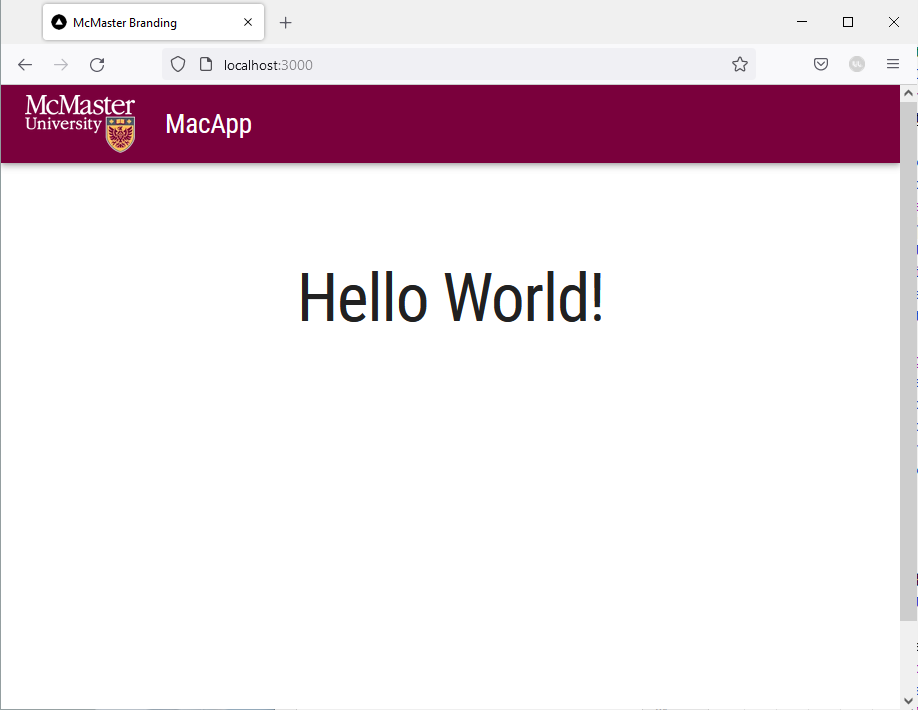 If you hover over the “MacApp” button, the text should turn Heritage Gold indicating that this is a clickable link.
If you hover over the “MacApp” button, the text should turn Heritage Gold indicating that this is a clickable link.
Try decreasing the width of your window and notice how a new menu icon will be shown along with a smaller logo: 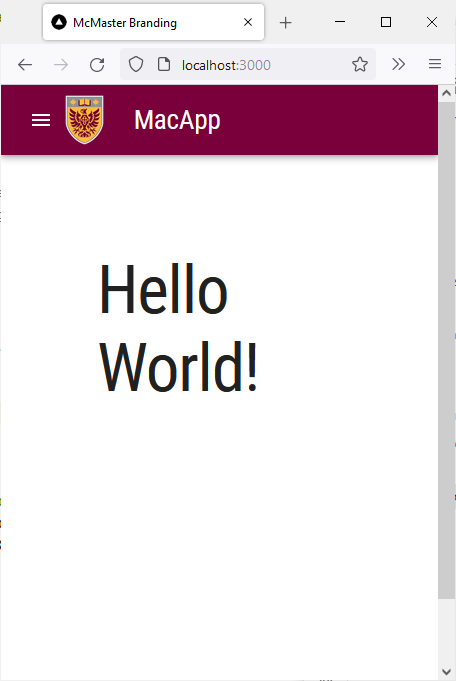
Create Additional Pages
Start by creating an additional page CSS style in page.module.css:
.page {
display: flex;
flex-direction: column;
justify-content: space-between;
align-items: center;
min-height: calc(100vh - 164px);
padding-top: 1rem;
}
We reduced the padding compared to the main style.
In the app directory of your project, create a new directory called page_1. Create an page.tsx file in the page_1 directory. Add the following code to the page_1/page.tsx file:
'use client';
import styles from '@/styles/page.module.css'
import Typography from '@mui/material/Typography'
import {useEffect} from "react";
import Container from "@mui/material/Container";
import Box from "@mui/material/Box";
export default function Page_1() {
useEffect(() => {
document.title = 'Page 1'
}, [])
return (
<>
<main className={styles.page}>
<Container>
<Box
display="flex"
justifyContent="center"
alignItems="center">
<Typography variant="h1">Page 1</Typography>
</Box>
</Container>
</main>
</>
)
}
Create another directory in app called page_2 with an page.tsx file in it. Add the following code to page_2/page.tsx:
'use client';
import styles from '@/styles/page.module.css'
import Typography from '@mui/material/Typography'
import {useEffect} from "react";
import Container from "@mui/material/Container";
import Box from "@mui/material/Box";
export default function Page_2() {
useEffect(() => {
document.title = 'Page 2'
}, [])
return (
<>
<main className={styles.page}>
<Container>
<Box
display="flex"
justifyContent="center"
alignItems="center">
<Typography variant="h1">Page 2</Typography>
</Box>
</Container>
</main>
</>
)
}
These two files create two simple pages that show a title in the middle akin to the main “Hello World!” page. We use the React Effect Hook to add a document title on each page that will be shown as the tab name in your browser.
Create Styled Buttons
We will now create a styled Button for use in our navigation bar. Inside the previously created MacComponents/MacNavButton.tsx file, add the following import statement:
import Button from '@mui/material/Button'
Next, create and export the styled MacNavButton component:
export const MacNavButton = styled(Button)(props => ({
':hover': {
backgroundColor: "transparent",
color: useTheme().palette.secondary.main,
},
'&& .MuiTouchRipple-child': {
backgroundColor: "#D6D6D6",
},
})) as typeof Button
Your MacComponents/MacNavButton.tsx file should now containing the following lines of code:
import {styled, useTheme} from '@mui/material/styles'
import Button from '@mui/material/Button'
import IconButton from '@mui/material/IconButton'
export const MacNavButton = styled(Button)(props => ({
':hover': {
backgroundColor: "transparent",
color: useTheme().palette.secondary.main,
},
'&& .MuiTouchRipple-child': {
backgroundColor: "#D6D6D6",
},
})) as typeof Button
export const MacIconNavButton = styled(IconButton)(props => ({
':hover': {
backgroundColor: "transparent",
color: useTheme().palette.secondary.main,
},
'&& .MuiTouchRipple-child': {
backgroundColor: "#D6D6D6",
},
})) as typeof IconButton
The MacNavButton component is a styled MUI Button that behaves similarly to the MacIconNavButton. The text color of the button turns to Heritage Gold when hovering over it. We also added a ripple affect to the button that appears when the user clicks the button.
Add Links to the Navigation Bar
Import the MacNavButton components in Navbar.tsx by updating the import statement of the MacIconNavButton as shown below:
import {MacIconNavButton, MacNavButton,} from '@/components/MacComponents/MacNavButton'
Next, add the following additional import statements:
import ListItem from "@mui/material/ListItem";
import ListItemButton from "@mui/material/ListItemButton";
import ListItemIcon from "@mui/material/ListItemIcon";
import ListItemText from "@mui/material/ListItemText";
import LooksOneIcon from '@mui/icons-material/LooksOne';
import LooksTwoIcon from '@mui/icons-material/LooksTwo';
In the Navbar function of Navbar.tsx, add the following lines of code after the toggleDrawer function declaration:
const router = useRouter()
const currentRoute = usePathname()
const icons = [<LooksOneIcon key={'transcripts-page'} />, <LooksTwoIcon key={'privacy-policy'}/>]
The code initializes the router object and determines which page the user is currently on. We also defined an array of icons that we will use in the drawer that is shown on small screens.
Modify the pages_drawer constant by adding the following lines of code inside the List component:
{pages.map((page, index) => (
<ListItem key={page[0]} disablePadding>
<ListItemButton onClick={toggleDrawer(false)} component={Link} href={page[1]} selected= {currentRoute === page[1]} >
<ListItemIcon>
{icons[index]}
</ListItemIcon>
<ListItemText primary={page[0]} />
</ListItemButton>
</ListItem>
))}
We iterate on the pages array and add an ListItem component for each entry. Each ListItem component contains a ListItemButton, a ListItemIcon and a ListItemText component. Each entry is rendered as a clickable link consisting of an icon followed by the name of the page.
Next, we will add the navigation button links shown on medium-sized displays. Add the following code right after the second Typography component:
<Box sx={{flexGrow: 1, display: {xs: 'none', md: 'flex'}}}>
{pages.map(page => (
<MacNavButton
key={page[0]}
component={Link}
href={page[1]}
className={
currentRoute === page[1]
? styles.active
: styles.nonActive
}
sx={{mx: 0.3, my: 2, color: 'white', display: 'block'}}
>
{page[0]}
</MacNavButton>
))}
</Box>
s
We modify the className of the MacNavButton component depending on which page the user is currently on to specify if the button should use the active style or the nonActive style.
The Navbar.tsx file should now contain the following code:
import * as React from 'react'
import AppBar from '@mui/material/AppBar'
import Box from '@mui/material/Box'
import Toolbar from '@mui/material/Toolbar'
import Typography from '@mui/material/Typography'
import MenuIcon from '@mui/icons-material/Menu'
import Container from '@mui/material/Container'
import Link from 'next/link'
import {usePathname, useRouter} from 'next/navigation'
import styles from '@/styles/NavBar.module.css'
import {MacIconNavButton, MacNavButton,} from '@/components/MacComponents/MacNavButton'
import Tooltip from '@mui/material/Tooltip'
import Drawer from "@mui/material/Drawer";
import List from "@mui/material/List";
import ClearIcon from '@mui/icons-material/Clear';
import ListItem from "@mui/material/ListItem";
import ListItemButton from "@mui/material/ListItemButton";
import ListItemIcon from "@mui/material/ListItemIcon";
import ListItemText from "@mui/material/ListItemText";
import LooksOneIcon from '@mui/icons-material/LooksOne';
import LooksTwoIcon from '@mui/icons-material/LooksTwo';
const pages = [
['Page 1', '/page_1'],
['Page 2', '/page_2'],
]
export default function Navbar() {
const imgStyle = {
paddingTop: '10px',
paddingBottom: '10px',
paddingRight: '30px',
}
const [state, setState] = React.useState(false);
const toggleDrawer =
(open: boolean) =>
(event: React.KeyboardEvent | React.MouseEvent) => {
if (
event.type === 'keydown' &&
((event as React.KeyboardEvent).key === 'Tab' ||
(event as React.KeyboardEvent).key === 'Shift')
) {
return;
}
setState(open);
};
const router = useRouter()
const currentRoute = usePathname()
const icons = [<LooksOneIcon key={'transcripts-page'} />, <LooksTwoIcon key={'privacy-policy'}/>]
const pages_drawer = () => (
<Box
paddingTop={1}
sx={{ width: 250 }}
role="presentation"
onKeyDown={toggleDrawer(false)}
>
<List>
{pages.map((page, index) => (
<ListItem key={page[0]} disablePadding>
<ListItemButton onClick={toggleDrawer(false)} component={Link} href={page[1]} selected= {currentRoute === page[1]} >
<ListItemIcon>
{icons[index]}
</ListItemIcon>
<ListItemText primary={page[0]} />
</ListItemButton>
</ListItem>
))}
</List>
</Box>
);
return (
<AppBar
position="relative"
enableColorOnDark
style={{backgroundImage: 'none'}}
sx={{zIndex: theme => theme.zIndex.drawer + 1, borderRadius: 0}}
>
<Container maxWidth="xl">
<Toolbar disableGutters>
<Box sx={{flexGrow: 1, display: {xs: 'flex', md: 'none'}}}>
<MacIconNavButton
size="large"
aria-controls="menu-appbar"
aria-haspopup="true"
onClick={toggleDrawer(!state)}
color="inherit"
>
{state ? <ClearIcon /> : <MenuIcon />}
</MacIconNavButton>
<Drawer
anchor={"left"}
open={state}
onClose={toggleDrawer(false)}
sx={{
'& .MuiDrawer-root': {
position: 'absolute'
},
'& .MuiPaper-root': {
position: 'absolute',
borderRadius: 0
},
minWidth: 100,
width: "20%",
position: "absolute",
top: '70px',
display: {xs: 'flex', md: 'none'}
}}
>
{pages_drawer()}
</Drawer>
<Box
justifyContent="center"
alignItems="center"
sx={{alignItems: 'center', display: {xs: 'flex', md: 'none'}}}
>
<Box
component="img"
sx={{
height: 70,
width: '100%',
}}
alt="McMaster Logo"
src="/assets/logo-small.png"
style={imgStyle}
/>
<Typography
variant="h3"
component={Link}
href="/"
sx={{
mr: 2,
flexGrow: 1,
color: 'inherit',
textDecoration: 'none',
"&:hover": {
color: useTheme().palette.secondary.main
}
}}
>
MacApp
</Typography>
</Box>
</Box>
<Box
component="img"
sx={{
height: 78.31,
width: 140,
display: {xs: 'none', md: 'flex'}
}}
alt="McMaster Logo"
src="/assets/logo.png"
style={imgStyle}
/>
<Typography
variant="h3"
noWrap
component={Link}
href="/"
sx={{
mr: 2,
display: {xs: 'none', md: 'flex'},
textDecoration: 'none',
color: 'inherit',
"&:hover": {
color: useTheme().palette.secondary.main
}
}}
>
MacScribe
</Typography>
<Box sx={{flexGrow: 1, display: {xs: 'none', md: 'flex'}}}>
{pages.map(page => (
<MacNavButton
key={page[0]}
component={Link}
href={page[1]}
className={
currentRoute === page[1]
? styles.active
: styles.nonActive
}
sx={{my: 2, color: 'white', display: 'block'}}
>
{page[0]}
</MacNavButton>
))}
</Box>
</Toolbar>
</Container>
</AppBar>
);
}
Your webpage should now have two button links in the navigation bar. The buttons will turn Heritage Gold when you hover over them.

Clicking on a button will take you to the corresponding page.  Notice that the button of the active page has a white background to inform the user which page they are currently on.
Notice that the button of the active page has a white background to inform the user which page they are currently on.
On smaller screens the navigation bar will make use of an app drawer where the active page is highlighted: 
Add a Settings Button
In this section, we will add an icon button that redirects the user to the “Settings” page of our web application. The “Settings” page will use vertical tabs to display and group related controls. We will also learn how to add a tooltip message to an icon button to help our users understand what each icon in our navigation bar signifies.
Start by adding the following import statement to Navbar.tsx:
import SettingsIcon from '@mui/icons-material/Settings'
We are importing the MUI “Settings” icon (gear icon) for use in our navigation bar and app drawer.
Add the following lines of code immediately after the Box component containing the MacNavButtons for “Page 1” and “Page 2”:
<Box sx={{paddingRight: 1}}>
<Tooltip
title= "Settings"
>
<MacIconNavButton
aria-label="settings"
color="inherit"
component={Link}
className={
currentRoute === '/settings'
? styles.active
: styles.nonActive
}
href="/settings"
>
<SettingsIcon />
</MacIconNavButton>
</Tooltip>
</Box>
We are effectively adding a new Box component that contains an instance of the MacIconNavButton styled component that we created earlier. The MacIconNavButton contains the SettingsIcon component that appears as a gear icon. Notice the MacIconNavButton is wrapped in a Tooltip component which allows us to present the user with a tooltip message when they hover over the gear icon. Currently, the settings icon button is set to redirect the user to the settings page, which we will create shortly.
On small screens, the settings link should be displayed at the bottom of the app drawer. Modify the pages_drawer function to render a settings link as shown below:
const pages_drawer = () => (
<Box
paddingTop={1}
sx={{ width: 250 }}
role="presentation"
onKeyDown={toggleDrawer(false)}
>
<List>
{pages.map((page, index) => (
<ListItem key={page[0]} disablePadding>
<ListItemButton onClick={toggleDrawer(false)} component={Link} href={page[1]} selected= {currentRoute === page[1]} >
<ListItemIcon>
{icons[index]}
</ListItemIcon>
<ListItemText primary={page[0]} />
</ListItemButton>
</ListItem>
))}
</List>
<List style={{ position: "absolute", bottom: "0", right: "0", left: "0"}}>
<ListItem key={'settings'} disablePadding>
<ListItemButton onClick={toggleDrawer(false)} component={Link} href={'/settings'} selected= {currentRoute === '/settings'} color="inherit" >
<ListItemIcon>
<SettingsIcon />
</ListItemIcon>
<ListItemText primary={'Settings'} />
</ListItemButton>
</ListItem>
</List>
</Box>
);
Your Navbar.tsx file should now look like this:
import * as React from 'react'
import AppBar from '@mui/material/AppBar'
import Box from '@mui/material/Box'
import Toolbar from '@mui/material/Toolbar'
import Typography from '@mui/material/Typography'
import MenuIcon from '@mui/icons-material/Menu'
import Container from '@mui/material/Container'
import Link from 'next/link'
import {usePathname, useRouter} from 'next/navigation'
import styles from '@/styles/NavBar.module.css'
import {MacIconNavButton, MacNavButton,} from '@/components/MacComponents/MacNavButton'
import Tooltip from '@mui/material/Tooltip'
import Drawer from "@mui/material/Drawer";
import List from "@mui/material/List";
import ClearIcon from '@mui/icons-material/Clear';
import ListItem from "@mui/material/ListItem";
import ListItemButton from "@mui/material/ListItemButton";
import ListItemIcon from "@mui/material/ListItemIcon";
import ListItemText from "@mui/material/ListItemText";
import LooksOneIcon from '@mui/icons-material/LooksOne';
import LooksTwoIcon from '@mui/icons-material/LooksTwo';
import SettingsIcon from '@mui/icons-material/Settings'
const pages = [
['Page 1', '/page_1'],
['Page 2', '/page_2'],
]
export default function Navbar() {
const imgStyle = {
paddingTop: '10px',
paddingBottom: '10px',
paddingRight: '30px',
}
const [state, setState] = React.useState(false);
const toggleDrawer =
(open: boolean) =>
(event: React.KeyboardEvent | React.MouseEvent) => {
if (
event.type === 'keydown' &&
((event as React.KeyboardEvent).key === 'Tab' ||
(event as React.KeyboardEvent).key === 'Shift')
) {
return;
}
setState(open);
};
const router = useRouter()
const currentRoute = usePathname()
const icons = [<LooksOneIcon key={'transcripts-page'} />, <LooksTwoIcon key={'privacy-policy'}/>]
const pages_drawer = () => (
<Box
paddingTop={1}
sx={{ width: 250 }}
role="presentation"
onKeyDown={toggleDrawer(false)}
>
<List>
{pages.map((page, index) => (
<ListItem key={page[0]} disablePadding>
<ListItemButton onClick={toggleDrawer(false)} component={Link} href={page[1]} selected= {currentRoute === page[1]} >
<ListItemIcon>
{icons[index]}
</ListItemIcon>
<ListItemText primary={page[0]} />
</ListItemButton>
</ListItem>
))}
</List>
<List style={{ position: "absolute", bottom: "0", right: "0", left: "0"}}>
<ListItem key={'settings'} disablePadding>
<ListItemButton onClick={toggleDrawer(false)} component={Link} href={'/settings'} selected= {currentRoute === '/settings'} color="inherit" >
<ListItemIcon>
<SettingsIcon />
</ListItemIcon>
<ListItemText primary={'Settings'} />
</ListItemButton>
</ListItem>
</List>
</Box>
);
return (
<AppBar
position="relative"
enableColorOnDark
style={{backgroundImage: 'none'}}
sx={{zIndex: theme => theme.zIndex.drawer + 1, borderRadius: 0}}
>
<Container maxWidth="xl">
<Toolbar disableGutters>
<Box sx={{flexGrow: 1, display: {xs: 'flex', md: 'none'}}}>
<MacIconNavButton
size="large"
aria-controls="menu-appbar"
aria-haspopup="true"
onClick={toggleDrawer(!state)}
color="inherit"
>
{state ? <ClearIcon /> : <MenuIcon />}
</MacIconNavButton>
<Drawer
anchor={"left"}
open={state}
onClose={toggleDrawer(false)}
sx={{
'& .MuiDrawer-root': {
position: 'absolute'
},
'& .MuiPaper-root': {
position: 'absolute',
borderRadius: 0
},
minWidth: 100,
width: "20%",
position: "absolute",
top: '70px',
display: {xs: 'flex', md: 'none'}
}}
>
{pages_drawer()}
</Drawer>
<Box
justifyContent="center"
alignItems="center"
sx={{alignItems: 'center', display: {xs: 'flex', md: 'none'}}}
>
<Box
component="img"
sx={{
height: 70,
width: '100%',
}}
alt="McMaster Logo"
src="/assets/logo-small.png"
style={imgStyle}
/>
<Typography
variant="h3"
component={Link}
href="/"
sx={{
mr: 2,
flexGrow: 1,
color: 'inherit',
textDecoration: 'none',
"&:hover": {
color: useTheme().palette.secondary.main
}
}}
>
MacApp
</Typography>
</Box>
</Box>
<Box
component="img"
sx={{
height: 78.31,
width: 140,
display: {xs: 'none', md: 'flex'}
}}
alt="McMaster Logo"
src="/assets/logo.png"
style={imgStyle}
/>
<Typography
variant="h3"
noWrap
component={Link}
href="/"
sx={{
mr: 2,
display: {xs: 'none', md: 'flex'},
textDecoration: 'none',
color: 'inherit',
"&:hover": {
color: useTheme().palette.secondary.main
}
}}
>
MacScribe
</Typography>
<Box sx={{flexGrow: 1, display: {xs: 'none', md: 'flex'}}}>
{pages.map(page => (
<MacNavButton
key={page[0]}
component={Link}
href={page[1]}
className={
currentRoute === page[1]
? styles.active
: styles.nonActive
}
sx={{my: 2, color: 'white', display: 'block'}}
>
{page[0]}
</MacNavButton>
))}
</Box>
<Box sx={{paddingRight: 1, display: {xs: 'none', md: 'flex'}}}>
<Tooltip title="Settings">
<MacIconNavButton
aria-label="settings"
color="inherit"
component={Link}
className={
currentRoute === '/settings'
? styles.active
: styles.nonActive
}
href="/settings"
>
<SettingsIcon />
</MacIconNavButton>
</Tooltip>
</Box>
</Toolbar>
</Container>
</AppBar>
);
}
Your navigation bar will now contain a settings icon on the right hand side. Hovering your mouse over the settings icon will turn it Heritage Gold and display a tooltip message.  Try reducing the width of your browser window to simulate a small-screen device. The app drawer will have a settings link at the bottom of the list.
Try reducing the width of your browser window to simulate a small-screen device. The app drawer will have a settings link at the bottom of the list.
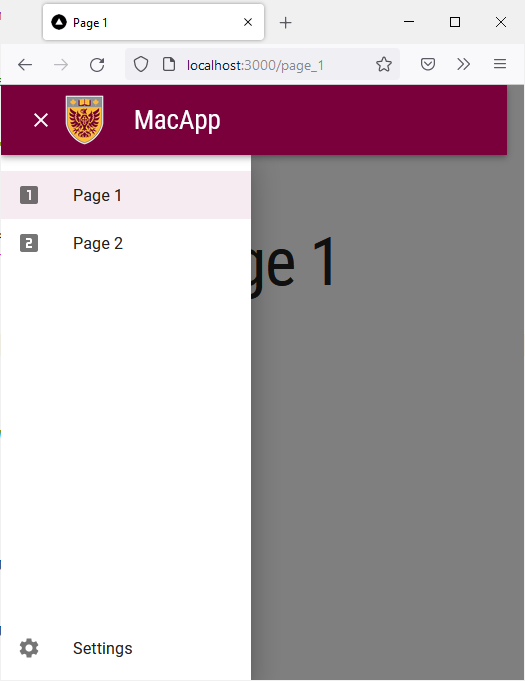
Creating the VerticalTabs Component
As previously mentioned, our settings page will make use of vertical tabs to group related controls. We will now create our custom VerticalTabs component using the MUI Tab component for medium and large display and a small drawer for mobile devices.
In the components directory, create a subdirectory called TabPanel. Inside this new subdirectory, create a file called VerticalTabs.tsx.
Add the following code to VerticalTabs.tsx:
import * as React from 'react'
import Tabs from '@mui/material/Tabs'
import Tab from '@mui/material/Tab'
import Typography from '@mui/material/Typography'
import Box from '@mui/material/Box'
import Drawer from '@mui/material/Drawer';
import List from '@mui/material/List';
import ListItem from '@mui/material/ListItem';
import ListItemButton from '@mui/material/ListItemButton';
import ListItemIcon from '@mui/material/ListItemIcon';
import ListItemText from '@mui/material/ListItemText';
import NotificationsNoneOutlinedIcon from '@mui/icons-material/NotificationsNoneOutlined';
import LockOutlinedIcon from '@mui/icons-material/LockOutlined';
import SettingsAccessibilityOutlinedIcon from '@mui/icons-material/SettingsAccessibilityOutlined';
import ManageAccountsOutlinedIcon from '@mui/icons-material/ManageAccountsOutlined';
import FormatListBulletedOutlinedIcon from '@mui/icons-material/FormatListBulletedOutlined';
import IconButton from "@mui/material/IconButton";
interface TabPanelProps {
children?: React.ReactNode
index: number
value: number
}
function TabPanel(props: TabPanelProps) {
const {children, value, index, ...other} = props
return (
<div
role="tabpanel"
hidden={value !== index}
id={`vertical-tabpanel-${index}`}
aria-labelledby={`vertical-tab-${index}`}
{...other}
>
{value === index && (
<Box sx={{p: 3}}>
<Typography>{children}</Typography>
</Box>
)}
</div>
)
}
function a11yProps(index: number) {
return {
id: `vertical-tab-${index}`,
'aria-controls': `vertical-tabpanel-${index}`,
}
}
export default function VerticalTabs() {
const [value, setValue] = React.useState(0)
const handleChange = (event: React.SyntheticEvent, newValue: number) => {
setValue(newValue)
}
const tabs = ['Notifications', 'Privacy', 'Accessibility', 'Account'];
const icons = [<NotificationsNoneOutlinedIcon key={'notifications'}/>, <LockOutlinedIcon key={'privacy'}/>, <SettingsAccessibilityOutlinedIcon key={'accessibility'}/>, <ManageAccountsOutlinedIcon key={'account'}/>]
const handleChangeDrawer = (e: React.MouseEvent<HTMLDivElement>, newValue: number) => {
setValue(newValue);
}
const [state, setState] = React.useState(false);
const toggleDrawer =
(open: boolean) =>
(event: React.KeyboardEvent | React.MouseEvent) => {
if (
event.type === 'keydown' &&
((event as React.KeyboardEvent).key === 'Tab' ||
(event as React.KeyboardEvent).key === 'Shift')
) {
return;
}
setState(open);
};
const list = () => (
<Box
sx={{ width: 250 }}
role="presentation"
onClick={toggleDrawer(false)}
onKeyDown={toggleDrawer(false)}
>
<List>
{tabs.map((text, index) => (
<ListItem key={text} disablePadding>
<ListItemButton selected= {value === index} onClick={(e) => handleChangeDrawer(e, index)}>
<ListItemIcon>
{icons[index]}
</ListItemIcon>
<ListItemText primary={text} />
</ListItemButton>
</ListItem>
))}
</List>
</Box>
);
return (
<>
<Box sx={{flexGrow: 1, bgcolor: 'background.paper', display: 'flex'}}>
<Tabs
orientation="vertical"
variant="scrollable"
value={value}
onChange={handleChange}
aria-label="Vertical tabs"
sx={{borderRight: 1, borderColor: 'divider', display: {xs: 'none', md: 'flex'}}}
>
{tabs.map((text, index) => (
<Tab key={text} label={text} icon={icons[index]} iconPosition="start" {...a11yProps(index)} sx={{justifyContent: 'left'}} />
))}
</Tabs>
<Box sx={{paddingTop: '19px'}}>
<IconButton title="Settings Drawer" aria-label="settings-menu" onClick={toggleDrawer(true)} sx={{ display: {xs: 'inline', md: 'none'}, height:'40px'}}> <FormatListBulletedOutlinedIcon /> </IconButton>
</Box>
<Drawer
anchor={"left"}
open={state}
onClose={toggleDrawer(false)}
sx={{
'& .MuiDrawer-root': {
position: 'absolute'
},
'& .MuiPaper-root': {
position: 'absolute'
},
minWidth: 100,
width: "20%",
position: "absolute",
top: '230px',
left: '2%',
height: '50%',
display: {xs: 'flex', md: 'none'}
}} >
{list()}
</Drawer>
<TabPanel value={value} index={0}>
<Typography
sx={{display: {xs: 'flex', md: 'none'}, justifyContent: 'left', paddingLeft: '10px'}}
variant="settingTitle"
gutterBottom
>
Notifications
</Typography>
Placeholder
</TabPanel>
<TabPanel value={value} index={1}>
<Typography
sx={{display: {xs: 'flex', md: 'none'}, justifyContent: 'left', paddingLeft: '10px'}}
variant="settingTitle"
gutterBottom
>
Privacy
</Typography>
Placeholder
</TabPanel>
<TabPanel value={value} index={2}>
<Typography
sx={{display: {xs: 'flex', md: 'none'}, justifyContent: 'left', paddingLeft: '10px'}}
variant="settingTitle"
gutterBottom
>
Accessibility
</Typography>
Placeholder
</TabPanel>
<TabPanel value={value} index={3}>
<Typography
sx={{display: {xs: 'flex', md: 'none'}, justifyContent: 'left', paddingLeft: '10px'}}
variant="settingTitle"
gutterBottom
>
Account
</Typography>
Placeholder
</TabPanel>
</Box>
</>
)
}
The layout of the VerticalTabs changes depending on the display size of the device viewing the page. We created a custom TabPanel component that will house the content of each tab in our panel. For medium and large displays, we made use of the MUI Tabs component with several children Tab components containing the label of each tab. The tabs are displayed vertically on the left hand side of the screen. The handleChange function allows the user to easily switch between the tabs by clicking on the desired label. Currently, each tab panel contains a simple placeholder string. We will add styled form controls to some of the panels in a later section of this learning module. On small screens, the tabs are automatically moved to a Drawer component that can be activated using an IconButton. Switching between the Tabs and Drawer components by resizing the browser window will save the user’s current position (i.e., the current tab that they are on). The current active tab is always highlighted on both the full-sized tabs as well as the drawer.
Create the Settings Page
Start by creating a CSS style for the settings page. Add the following lines to styles/page.module.css:
.settings {
display: flex;
flex-direction: column;
justify-content: space-between;
align-items: center;
min-height: calc(100vh - 164px);
padding-top: 1rem;
padding-bottom: 2rem;
}
We reduced the padding used at the top and bottom of the settings page compared to the .main style.
Now that our VerticalTabs component is complete, we will create the settings page index file. In the app directory of your project, create a new settings subdirectory. Create an page.tsx file in this directory.
Add the following code to settings/page.tsx:
'use client';
import styles from '@/styles/page.module.css'
import Typography from '@mui/material/Typography'
import * as React from 'react'
import {useEffect} from 'react'
import Box from '@mui/material/Box'
import VerticalTabs from '@/components/TabPanel/VerticalTabs'
import {Container} from '@mui/material'
export default function Settings() {
useEffect(() => {
document.title = 'Settings'
}, [])
return (
<main className={styles.settings}>
<Container>
<Typography
sx={{display: 'flex', justifyContent: 'center'}}
variant="h2"
gutterBottom
>
Settings
</Typography>
<Box sx={{width: '100%', maxWidth: 1000}}>
<VerticalTabs />
</Box>
</Container>
</main>
)
}
We added Container that includes a Typography component to display the title of the page using the h2 variant. We also added a Box component containing the VerticalTabs. The Effect Hook is used to change the document title shown in the browser tab.
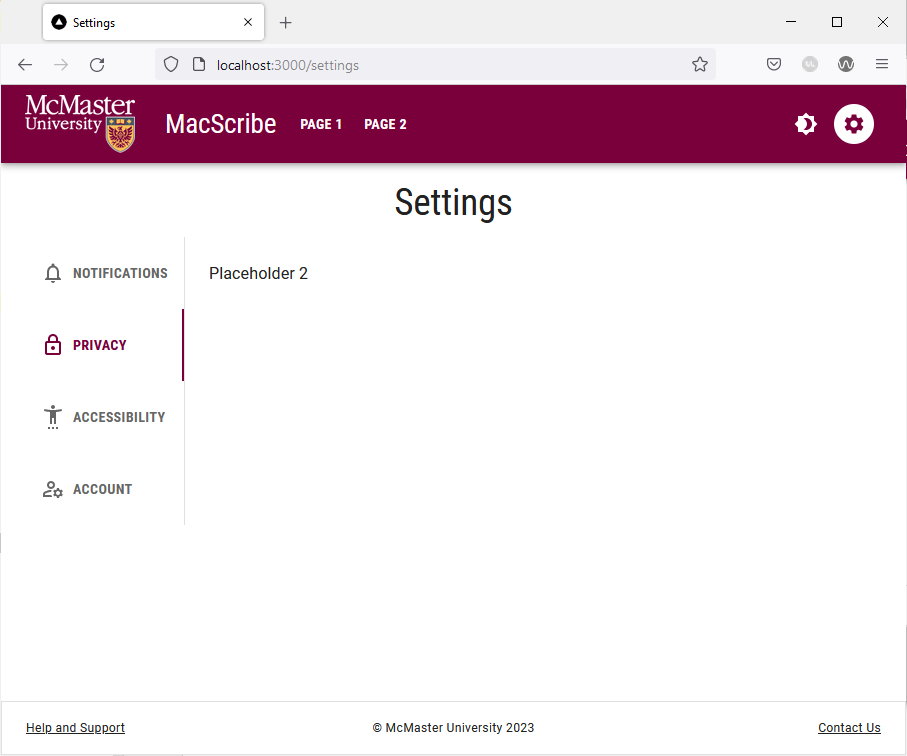
Go back to your browser and try clicking on the settings icon in the navigation bar. You will be redirected to the settings page with the vertical tabs. You can easily switch tabs by clicking on the label of the desired tab. Try shrinking your browser window horizontally and notice how the VerticalTabs component scales accordingly.
